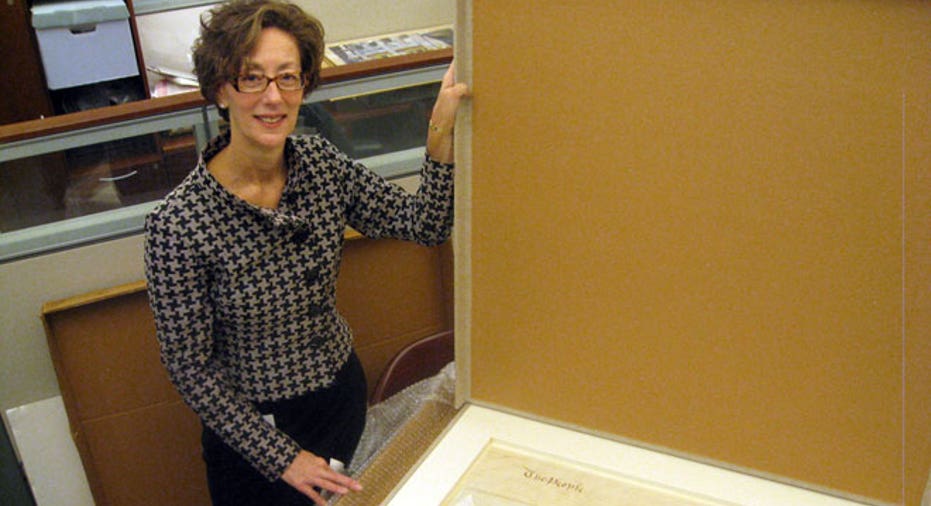Digging Through the Basement at JPMorgan Chase

Jean Elliott took me deep into the basement of 1 Chase Manhattan Plaza, where one of the world's largest banks stores its relics.
After more than 1,200 mergers and acquisitions, what is now J.P. Morgan Chase & Co. (NYSE:JPM) has amassed more than $2.2 trillion in assets. It has also taken on countless crates full of knickknacks from the banks it acquired--everything from bowling trophies to the fine china from JPMorgan's yacht.
Elliott showed me letters, ledgers, desk sets, hole punchers, coin dispensers, cablegrams, stocks, bonds, loan certificates, typewriters, antique coin banks, currencies, films and recordings. She's even showcased what looks like a cheerleader's outfit: A shapely red-white-and-blue uniform--sporting a big white star--that a Texas bank receptionist once had to wear.
For the past 23 years, it's been Elliott's job to organize this stuff in a 7,000-square-foot subterranean archive near Wall Street, and display it in client dining rooms, reception areas and boardrooms.
"A lot of companies don't know where they've been," said Elliott, who has degrees in history and library science. "They don't have a memory that's been documented, preserved and maintained."
Elliott said she and her colleagues have a long way to go before they've sorted through all the boxes from the 2008 acquisition of Washington Mutual. The 2008 takeover of financially troubled Bear Stearns, however, took hardly anytime at all.
"Unfortunately, they didn't maintain their history," she said. "We have a stack of annual reports. That's all we have."
Elliott is the keeper of her employer's original charter from 1799, a document that begins with big letters spelling out "The People" and then trails off into smaller lettering that is difficult to read.
Founded as The Manhattan Co. to supply "pure and wholesome" water to New York City, it built a gravity-fed network of hollowed-out pine logs. "These logs are still under the streets today," Elliott said. Sometimes construction crews jackhammer through pavement to discover these wooden pipes, but have no idea what they are or how they got there.
Manhattan Co. founder Aaron Burr was more interested in bank logs than water logs. The water company was his clever way of landing a bank charter, providing financing for a utility and its customers. Burr was also the third vice president of the United States under Thomas Jefferson. But he's more famous for killing his political rival, Alexander Hamilton, in a duel in 1804 in Weehawken, N.J.
Elliott showed me the original dueling pistols, which the bank keeps on display in a reception area on the 49th floor of its building at 270 Park Ave. in midtown Manhattan. When the bank decided to make precise replicas of the guns, a gunsmith discovered one of the originals had a hair trigger, which may explain why Burr won the shootout.
Also on display is the first dollar ever printed by the Federal Reserve Bank. It was presented to one of the bank's namesakes, Salmon P. Chase, in 1862, when he was Treasury Secretary under Abraham Lincoln.
"The history is something our clients engage with," Elliott said. "They're surprised to find out what we have."
Elliott has archived a signature card from actress Greta Garbo; a 1949 savings account book with more than $7 million; letters from Winston Churchill; orders for stock in U.S. Steel when it first went public in 1901; and architectural details, including marble reliefs, sculptures and fine furnishings from the days when bank lobbies displayed opulence instead of ATMs and prefab cubicles.
History also helps with promotions, Elliott said. When JPMorgan Chase launches a program for veterans, it can show what its many predecessors have done for veterans in decades past. When it celebrates an anniversary in China, it can start with a piece of its heritage there.
The archive began under former Chase Chairman David Rockefeller in 1975 and was one of the first places Jamie Dimon turned when he took the helm of the giant bank. "Jamie wanted to know, himself, what was he heading," Elliott explained.
So many marquee names have faded over the centuries into what is now the JPMorgan Chase brand: Manufacturers Hanover, Chemical Bank, First Chicago, National Bank of Detroit, Texas Commerce Bankshares, Brooklyn Trust Co., Second State Bank of Indiana, The Seaman's Bank for Savings, and Drexel Morgan & Co., to name a few.
People involved in bank mergers and acquisitions often just move on to the next thing, never thinking about the history they've assumed or the many shoulders upon which they've danced."The success of any single firm doesn't rest with a single individual," Elliott said. "That's part of why I am a passionate about connecting people with history."
This is never easy, though, when JPMorgan Chase is still making history.
"It just keeps coming," Elliott said. "Every merger just brings more and more material."
(Al's Emporium, written by Dow Jones Newswires columnist Al Lewis, offers commentary and analysis on a wide range of business subjects through an unconventional perspective. Contact Al at al.lewis@dowjones.com or tellittoal.com)